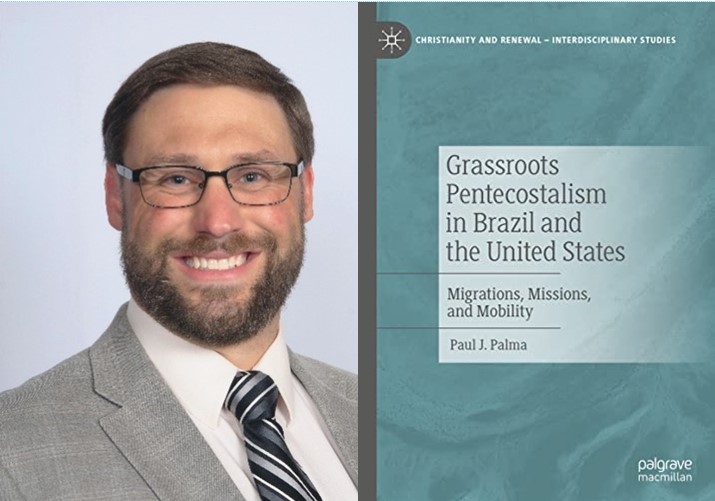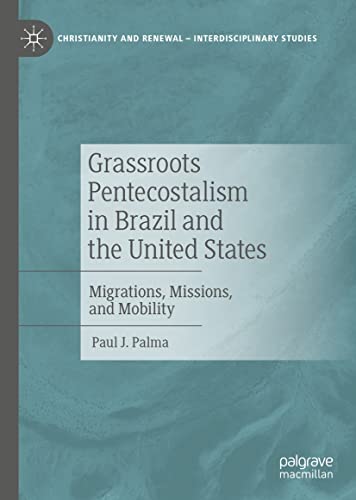Missions and Grassroots Pentecostalism: an interview with Paul Palma

An interview with Dr. Paul J. Palma about his book, Grassroots Pentecostalism in Brazil and the United States: Migrations, Missions, and Mobility
PneumaReview.com: Will you please introduce us to your newest book?
Paul Palma: This book offers an historical and comparative profile of classical Pentecostal movements in Brazil and the United States in view of their migratory beginnings and transnational expansion. Pentecostalism’s inception in the early twentieth century, particularly in its global South permutations, was defined by its grassroots character. In contrast to the top-down, hierarchical structure typical of Western forms of Christianity, the emergence of Latin American Pentecostalism embodied stability from the bottom up―among the common people. While the rise to prominence of the Assemblies of God in Brazil, the Western hemisphere’s largest (non-Catholic) denomination, demanded structure akin to mainline contexts, classical Pentecostals such as the Christian Congregation movement cling to their grassroots identity. Comparing the migratory and missional flow of movements with similar European and US roots, in this book, I consider the prospects for Brazilian Pentecostals with an eye on the problems of church growth and polity, gender, politics, and ethnic identity.
PneumaReview.com: What is the significance of the word “grassroots” in the title?
The development of Latin American Pentecostalism was characterized by growth among the lower and working-class.
PneumaReview.com: In the book you refer to the outpouring of the Holy Spirit in Chicago in 1907-08. Please tell our readers a little bit about the history of that move of God.
By 1910, the center of gravity of the Pentecostal awakening, particularly in its international reach, had shifted from Azusa Street to Chicago.
PneumaReview.com: Some key missionaries went out from Chicago to Brazil, who were they?
Paul Palma: Two Chicagoan missionary teams were integral in the founding of Brazilian Pentecostalism. The first was a group of Italian migrants and onetime Presbyterians. Luigi Francescon, accompanied by Lucia Menna and Giacomo Lombardi, arrived in South America in 1909. The Italians helped found the Brazilian Christian Assembly (CA) and Christian Congregation (CC) movements. The second was a duo of Baptist Swedes, Daniel Berg and Gunnar Vingren. The former Baptists Berg and Vingren arrived in Brazil in 1910 on their way to founding the Brazilian Assemblies of God (AD).
PneumaReview.com: What factors contributed to making their ministries so fruitful?
Early Pentecostalism was a vibrant missionary movement. Brazilian Pentecostalism was propelled by a passion for the ongoing ministry of the Spirit and a millenarianism that sought to win as many converts as possible before Christ’s imminent return.
PneumaReview.com: As you have pointed out in the book their work is still evident today in the ongoing ministry of three denominations. Please tell us briefly about each.
Paul Palma: Despite challenges, each of the denominations are bearing fruit today. The CC is now a decidedly international movement with congregations throughout Latin America, North America, Italy, and beyond. The AD remains the largest Western (non-Catholic) denomination with a membership of about 21 million, but its expansion has tapered over the last decade due to structural and political shifts. The CA endures throughout Latin (and North) America but has splintered into several different denominations, including the Pentecostal Christian Church, the Bible Christian Church, the Villa Devoto CA, and the CA God is Love.
PneumaReview.com: You highlight the fact that two of the denominations trace their roots back to Luigi Francescon. What issues caused the movement he started to divide into two groups?

Paul J. Palma, Grassroots Pentecostalism in Brazil and the United States: Migrations, Missions, and Mobility (Palgrave MacMillan, 2022).
Paul Palma: The chief difference between the Francescon-founded CC and CA is a regional one. Francescon pioneered the CC on Brazilian soil. A year before his 1910 arrival in Brazil, he founded the CA in Buenos Aires, Argentina. CA churches slowly made their way into Brazil and recently reunited through inter-ecclesial efforts that harken to their Chicagoan heritage. While Francescon concentrated on the CC in Brazil (based in São Paulo), another cohort of missionaries from Chicago filled the need for workers in Argentina, and the movement there developed peculiarities of its own. For instance, while the CC readily expanded among the native Portuguese population, the CA remained ethnically Italian and insulated from other churches well into the twentieth century.
PneumaReview.com: Do the Pentecostal churches in Brazil have different practices or priorities than most non-Brazilian Pentecostal churches in the United States?
Paul Palma: Besides the prevalence of Portuguese-speaking members, there are subtle cultural differences. The CC churches are distinguished from most other Pentecostal churches by their insistence that women wear head coverings (the “veil”) during public worship. You will also find less urgency for seminary training for ministers among the Brazilian churches. While Brazilian Pentecostals now encourage seminary training, they lacked the resources for educational institutes for many years. For the AD, because of reasons tied to its Swedish roots, even when educational resources were available, it favored a short-term Bible School training model over formal seminaries.
PneumaReview.com: At different points in the text, you mention “reverse mission,” for those who may be unfamiliar with that term please explain what it means.
The reverse mission shift: nations such as the United States, the United Kingdom, and France are now among the leading missionary-receiving countries in the world.
PR
Additional Resources
Read the review of Grassroots Pentecostalism in Brazil and the United States by Brian Roden
Watch the book launch introduction by Paul Palma
Category: Church History, Spring 2023


